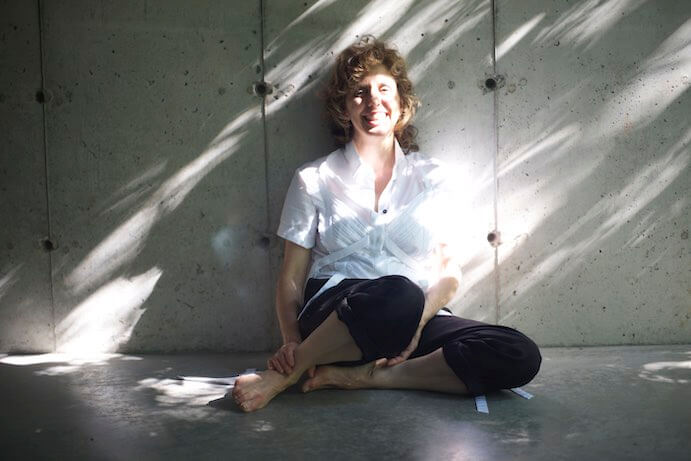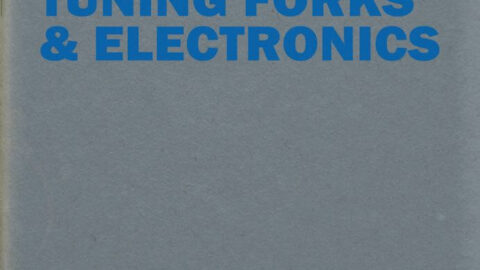Zeena Parkins’ Three Harps, Tuning Forks & Electronics (Good Child Music) explores both the expressive potential of the harp as well as the extent of its sonic possibilities. First constructed as the score for choreographer Neil Greenberg’s Really Queer Dance With Harps in 2008, Three Harps, Tuning Forks & Electronics translates and transforms this into a stand alone piece. Parkins–along with Nuiko Wadden, Kristen Theriault, and Megan Conley–creates a collective investigation of the myriad sounds of the harp, but also what can happen when their instruments make contact with other objects—ebows, basting brushes, metal bolts, rubber/hard yarn and wooden mallets, and two-inch ribbon. The resulting work is a kaleidoscopic endeavor that continuously pushes the boundaries of what the harp is capable of producing.
The opening track, Muted, begins with a two-note oscillating figure that repeats over and over as other rhythmic patterns are overlaid. The two-inch ribbon that mutes the strings creates a tinny sound that occasionally resembles something more percussive or guitar-like; it sometimes takes a moment to remember that the sounds are coming from three harps. The repeated two-note figure seems to evoke the transfer of weight from one foot to another both in the way that we walk, and more importantly, in the way that a dancer moves throughout space. With cascading waterfalls of sound and continuously interlocking rhythmic patterns, the colors of Muted envelop us in a world between the sparkly high register and the warm depth of the bass.

Determined brings in a more sinister sound with scratchy, overlapping tones and rapid strumming and plucking. The resulting sound mimics both vocal sirens and the gentle distorted hum of electronic feedback. Unless you are extremely well-versed in extended technique for harp, the skills employed make it nearly impossible to distinguish between harp, electronics, and tuning forks. This becomes one of the greatest strengths of the album—the blended electro-acoustic soundscape allows an otherworldly, immersive sonic experience.
With a slight rock-and-roll vibe, Mouse opens with a figure that resembles the interplay between kick drum and electric bass. This conversation, less melodic than the two tracks that came before, introduces the notion of competing ideas that return and expand throughout the track. Utilizing silence as an expressive gesture, disjointed figures create the unnerving feeling of a literal cat and mouse chase. A middle section introduces the electronics (aptly processed by Parkins herself), first with tiny bell-like sounds, and then the expansion of those into huge church bells. The pitter-patter of the scurrying mouse returns again only to be overshadowed by a simple melody that attempts, and ultimately succeeds, to overpower the frantic chase.
Tuning Forks includes electronics by Ikue Mori, which, when combined with the forks and harps themselves, again creates the all-encompassing sonic palette that Parkins had set up earlier. Here, the ambient world takes us to a somewhat magical landscape that is both meditative in its sustained drones and gentle drops of rain and eerie in its outbursts of rainforest noises (and even robotic or extraterrestrial sounds). Once established, we remain in this world of heavy reverb and layered processing for quite some time. I couldn’t help but wonder whether the original choreography would have helped give the track a sense of forward momentum or if the ten minutes of quiet suspension in time is a needed reprieve from the otherwise rhythmically driven album.

Drumming brings us back to the interlocking harp patterns of earlier tracks until percussive effects take over. When all three harpists commit to vigorous tapping on the wood of the instrument, the cascades of hand percussion create a parallel to the phasing of Reich’s Drumming that is not lost. As these patterns continue to morph and intersect with one another, they sound almost like the intricate footwork of several tap dancers. While the “drumming” itself continues for most of the track, an electronica reminiscent of Tuning Forks re-enters towards the end only to disrupt this highly energetic jam.
The final track, Coda, brings the album to a close through a song-like postscript that excels in its gently driving pulsation, fleeting melodic line, and continuously expanding harmonic material. Towards the end, an electronic aura appears in the distance and aggressively moves forward, obliterating all other sound until it fades away with a gentle sustained hum.
Three Harps, Tuning Forks & Electronics showcases not only the expressive potential of the harp itself, but also the resulting array of colors that Parkins’ signature extended techniques can create when combined with tuning forks and electronics. Each of the six tracks presents a different sonic landscape, yet as a whole, Three Harps, Tuning Forks & Electronics offers a complete package: an exceedingly creative, unique, and forward-sounding immersive experience.
























